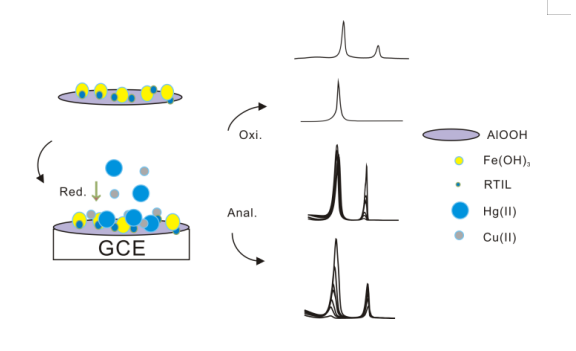[ China Instrument Network Instrument Development ] Heavy metal pollution is harmful to human health, so the research on the detection and mechanism of heavy metal ions has important scientific significance. Recently, Xiong Shiquan, a researcher at the Institute of Technical Biology, constructed complex electrode materials by hierarchical structure γ-AlOOH/Fe(OH)3 and ionic liquids to realize the analysis of Hg(II) and Cu(II) ions. This work has certain reference value for the detection and analysis of various heavy metal ions in the environment. Related research results have been published in Electrochimica Acta 287 (2018) 87-95.

In the electrochemical detection of heavy metal ions, most studies are performed on one or several ions. In this study, the research team used high-efficiency grading materials to construct electrodes, which not only realized the detection and analysis of heavy ions, but also further analyzed the mutual interference of several ions, and clarified the sensitivity and detection of single and simultaneous detection of heavy metals. The reason for the difference between the limits.
The researchers used ionic liquid/γ-AlOOH/Fe(OH)3 composites to construct electrode materials. By optimizing parameters and a series of material characterization, the problem of weak conductivity and low detection limit of the composites was solved. Further experimental results show that the detection limits of Cu(II) and Hg(II) can reach 0.5 and 0.2nM, and the sensitivity is 64.5 and 65.9 μA/μM, respectively. At the same time, Hg(II) and Cu(II) were separately and simultaneously electrochemically detected, and the sensitivity and detection limit of the two detections were found to vary to different extents. On this basis, the detection limits and sensitivity of Hg(II) and Cu(II) were deeply analyzed, and the reasons for the changes in Hg(II) and Cu(II) detection effects were experimentally explained. The researchers tested heavy metal ions in the soil and achieved good results.
This study designed a novel means of constructing electrode materials, and also provided a reference for the detection and analysis of various heavy metal ions. The above research work was supported by the Natural Science Foundation of Anhui Province, the National Natural Science Foundation, and the Joint Fund of the Technical Biological Institute.
(Original title: New progress in the detection and analysis of heavy metals in technical organisms)
Insulating Glass Sealing Robot
Insulating Glass Sealing Robot include three section:input section,sealing section,output section.Machine used to seal double glazing,triple glazing or step glazing.Automatic sealing robot adopt friendly man-machine interface which is concise and more convenient to operate.
Insulating Glass Sealing Robot with 2000mm*3000mm,2500*3500mm model.We also can produce machine according to your specific size.
Automatic Insulating Glass Sealing Robot,Manual Sealing Machine,Insulating Glass Sealing Robot,Double Glazing Sealing Machine
JINAN WEILI MACHINE CO LTD , https://www.wlglassmachines.com